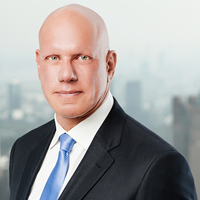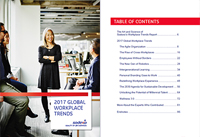The agility paradox: Cultivating agility in the organization of the future
Interview with Dr. Michael Bazigos, Managing Director at Accenture Strategy.
 Sodexo’s 2017 Workplace Trends Report is fresh off the presses with ten major trends that will impact our workplace today and in the years to come. Today we sat down with Dr. Michael Bazigos, Managing Director at Accenture Strategy, to talk about the growing need to adapt and be agile.
Sodexo’s 2017 Workplace Trends Report is fresh off the presses with ten major trends that will impact our workplace today and in the years to come. Today we sat down with Dr. Michael Bazigos, Managing Director at Accenture Strategy, to talk about the growing need to adapt and be agile.
What does it mean to be agile in the workplace?
Michael Bazigos: When we look at agility, there are two parallel systems that people reasonably assume work against each other: velocity and adaptiveness on one hand, and a stabilizing backbone of structure on the other. But the evidence is that agile companies have both. Most companies need hierarchy and structure, as it is needed for coordination, scale, and control. “Blowing up” the structure would be counterproductive, so the question is: how do you become agile anyway? A small number of organizations have developed structures, processes, and an overarching mindset that allows leaders to make decisions quickly, adapt to a changing environment and move fast without disrupting the very structural support which provides the stability for high velocity. Only 8 percent of companies have the ability to optimize speed and move as fast as the market requires to capture value.
Take for example a one-shot-wonder start-up – one that quickly brings to market a great product but lacks the processes of a mature organization like knowledge sharing systems, and finds that it can never replicate that initial success. Sustainable performance requires replicable processes, not just velocity and adaptiveness. Organizations without either fall further behind every year.
So what can be done to ensure the right level of flexibility?
M.B.: A useful reframe of that question is: what are the barriers to being agile in our organization? Leaders perhaps. Leaders need to handle change and motivate people during periods of uncertainty, but the ones who have this talent are in the minority. Leaders need to enable quick decision-making, and to cut through bureaucracies that have multiple levels of approvals – in effect, cultures where checkers are checking the checkers. While some processes may need to be controlled this way, when all processes are, there is a performance cost.
Change comes in a wide variety of flavors. We may have a product or service that is at risk for commoditization. Strategic agility is required to decide between saving the product or exiting the market in favor of a higher-value growth. We may have invested in an acquisition, but find the integration stalled, destroying value because time to realize expected benefits influences analysts’ valuation models, their buy-hold-sell recommendations, and ultimately our company’s share price.
The agility mindset is put to best use building structures with “soft-hard” properties. One example is maintaining the hard structure but building “soft” flexible bypass options, like a new app built to work on the same hardware. For example, if employees in public companies wish to speak to higher management directly, they can bypass normal procedures and processes, using a hotline to do so. Ordinarily, this is a compliance process compelled by legislation. But this level-bypass idea has been put to use in some agile organizations, where employees with great ideas which their line manager may be too busy for can instead speak to a community including senior managers empowered with resources to adopt and fund the idea’s implementation, if it’s seen as holding promise.
Flexible bypass options thus become the innovation analogue to whistle-blowers.
Can you provide a concrete example of what this bypass would look like in the work environment?
M.B.: Absolutely. Think about Starbucks. The company innovated extremely rapidly on one menu item, discovering in the process that it could use its baristas as human market sensors. At the time, customers were asking for soy milk in their coffee, which Starbucks did not provide. Its employees would have to individually go to the supermarket to buy a carton of soy milk on petty cash. All of this was unofficial, and fell under the broad mandate to delight customers. Eventually, word of this practice reached management, who then decided to offer soy milk options on their set menus. The company used its employees to harvest more richly what they were seeing and hearing on the front lines. They never dismantled their structure in the process; baristas were still baristas, and management was still management, but they invented soft processes around hard formal structure.
What does agility mean at the individual employee level?
M.B.: Employees need to step up and embrace ambiguity. One example is the employee resistance triggered when high-priority demands are made by management only to have a new high-priority request come along which may conflict with the earlier priority. The routine becomes running around and putting out fires, or picking one and avoiding the other, with results of burnout and/or low responsiveness over time. But what we really need is to flex with the situation, involve our managers in finding a good workaround, and change our expectations about a strictly defined and unchanging job role. Some employees are energized by that while others are not. People need to identify their tolerance to uncertainty and find ways to adapt at a personal level.
The new workforce is, to a greater extent than prior generations, more comfortable responding to multiple simultaneous stimuli, including technology, and they demonstrate a greater ability to multi-task. Flexibly toggling attention between several demands is an exercise in personal agility. In a competitive market, we need to accept that everything we believed about how success could be achieved may change suddenly and sometimes all at once, requiring us to rethink our entire plan.



